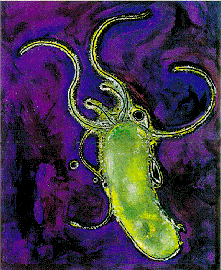How Does it Eat?
Helicobacter pylori is a heterotrophic, parasitic bacterium, meaning it does not produce its own food. By causing harm to its host, it gains its nutrients. It is not 100% clear how H. pylori gains nutrients, but test results have shown that the organism does not oxidize or ferment carbohydrates. (American Water Works Association 2006) Because it is a single celled bacteria, H. pylori does not have a need to transport nutrients within itself. It absorbs its nutrients across its plasma membrane.

(Helicobacter pylori does not actually use teeth to eat,
this picture is added for effect!)
The most obvious place from where it obtains nutrients is from its habitat, which just happens to be our storage place for nutrients! By colonizing the mucous layer of the stomach, the bacterium is in a prime location for nutrient uptake. It also obtains its nutrients from the mucous layer, itself. It is believed that H. pylori may cause inflammation of the mucosa, or gastritis, to gain even more nutrients (Marshall 1996). Talk about being greedy!
To learn how Helicobacter pylori is transmitted from host to host, click here.
